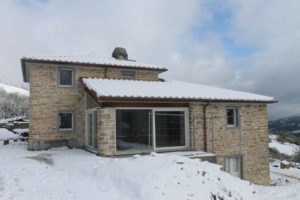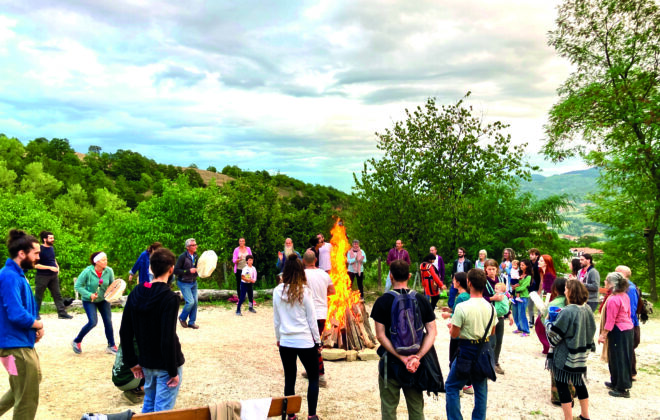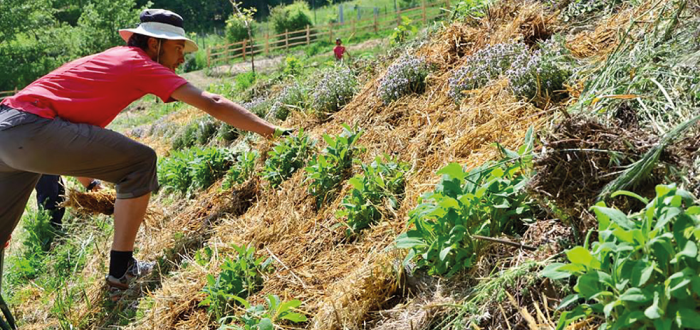GREEN RENOVATION OF THE HISTORICAL BUILDING “CASELLE DI PAGANICO”
After almost three years spent reorganizing the fields, terracing, creating vegetable gardens, building dry walls, fences, a water supply system, laying underground electric and telephone cables and planting ancient fruit trees, in 2014 we finally started the first renovation works of the historical building “Caselle di Paganico” in line with the pillars of the whole project. The renovation works involve a ruined building made of stone that probably dates back to the beginning of the XIX century and that will be turned into an organic agritourism.
We wanted a project focused on the historical characteristics of the building, energy efficiency and green building principles. So, we decided to turn to the expertise of Luigi Foschi, who loves to define himself as an “eco-surveyor”.
We met Luigi and he explained us some energy-saving features of the project.
Luigi, would you explain us why you decided to employ 100% hydraulic lime for the walls?
Hydraulic lime is one of the first binding materials used for building construction and it was already employed by the Romans thousands of years ago.
The raw material is limestone, which contains a low quantity of clay. Thanks to the absence of chemical agents and its mineral nature, it is a completely non-toxic material, perfect to be employed in green building.
Furthermore, hydraulic lime is permeable to water vapour, breathable and it regulates the level of humidity, hence preventing mould and mildew to develop.
Our intent was to employ a traditional, eco-friendly and recyclable raw material that at the same time could be functional, so this is why chose natural hydraulic lime.
How did you build the roof and why?
The roof is the final part of the building and it protects our house from atmospheric agents. Since it is usually wide, the roof is subject to heat dispersion as well as the walls. For this reason it is very important not to underestimate its design.
In our case, we chose a ventilated wooden roofing with multi-layered insulation made of wooden fibres. Ventilation allows humidity to be dispersed and the heat beneath the roof coating to be expelled.
In winter, thermal insulation can be reached by employing different insulating materials, while in summer dispersing heat is more complicated. This is why we need fibrous materials that can delay heat transmission to the building and in this case wooden fibres were the best possible choice.
What about window frames?
Window frames are a very important in terms of energy efficiency because they can disperse up to one fourth of the whole building energy. This percentage can be reduced up to 80% if we build window frames with excellent features.
For this reason we decided to build wooden frames and double glazed window. Wood has very good thermal transmittance value and endurance to wind, but this is not enough.
Indeed, even high-performance windows do not guarantee a good endurance if they are not carefully build and this may lead to draughts which causes condensation and mildews.
How the building will be heated?
Since the building is located in a hilly area, the focus was more on heating the building rather than cooling it. We opted for a radiant heating system in order to abide by the principles of energy efficiency we followed for the whole project. Radiant heating panels can be installed underfloor, in walls and ceilings depending on architectural choices and structural features.
This system heats the building through radiant heat. The internal air temperature for radiant heated buildings may be lower (20 °C ) than for a conventionally heated building (22/23 °C) to achieve the same level of body comfort, so the perceived temperature is actually the same.
What is very important to do right in this kind of renovation projects in order not to disperse energy?
Very simply, in order to reach high energy standards the key is to insulate and eliminate dispersions, as well as trying to keep the heat inside during winter and leave it outside during summer.
The four pillars of the Self-Sufficiency Farm project
1) Food Self-Sufficiency
Self-production of most of necessary food in order to run the centre and using as few fossil fuels as possible. We avoid chemical fertilizers, pesticides or any other product that cannot be naturally produced in the Farm
2) Energy self-sufficiency and green building
Our goal is to go completely off-grid by using solar, water, wind and biomass energy. We build in a smart and ecological way, in order to reduce energy consumption to minimum terms, reduce our environmental impact and host people in healthy and comfortable buildings.
3) Ecologic and Holistic education
We want to offer a suitable place that can grant high visibility to the main national and international experts who teaches how to build sustainable human installments, from the small house to an entire city thanks to permaculture, transition towns, happy degrowth, organic agriculture, synergistic agriculture, green building, energy self-sufficiency, holistic techniques and organic food.
4) Ecotourism and health
We would like people to experience sleeping in a healthy and natural place, breathing fresh air, drinking spring water, eating organic food, walking through the enchanting woods of the National Park of the Casentino Forests, Monte Falterona and Campigna, resting on a hammock beneath a big tree, getting massages at Bagno di Romagna thermal station, harmonizing body, mind and spirit through holistic techniques.
Newsletter
ARGOMENTI
- Activities (8)
- Attività (10)
- Attrattive (16)
- Cosa fare (22)
- Farm products (4)
- Fattoria dell'autosufficienza (39)
- Fattoria dell'autosufficienza (51)
- Fauna (8)
- Flora (5)
- I nostri modelli (14)
- Istruzioni per viaggiare (2)
- News (63)
- News (96)
- Our models (14)
- Permacultura (30)
- Permaculture (23)
- Prodotti della fattoria (4)
- Senza categoria (4)
- Senza categoria (2)
- Things to do (22)
- Tourist attractions (15)









